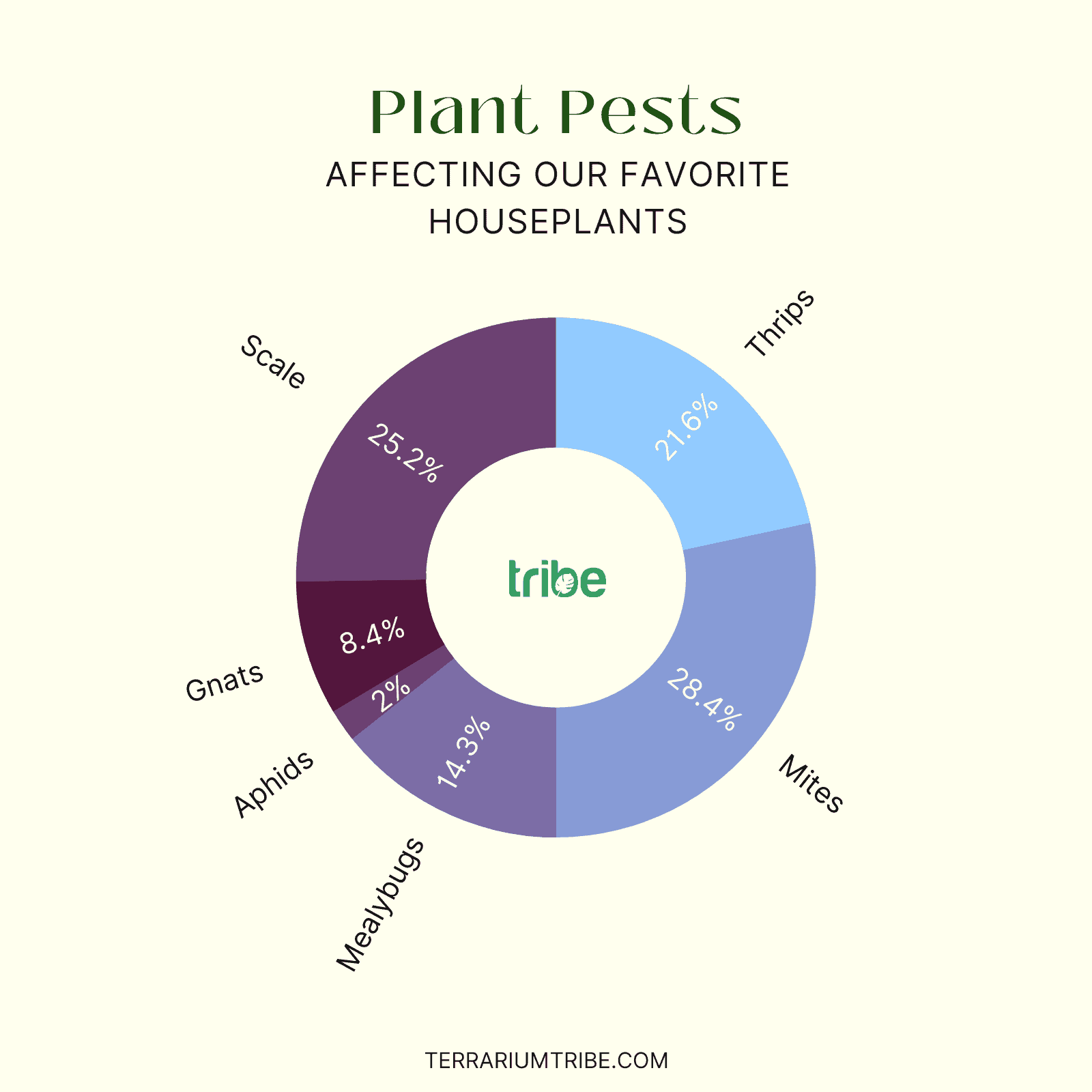When a plant issue comes up, Google is the first place people go for a diagnosis.
Searches like, “help, my Pothos leaves are turning brown” or “thrips on Monstera” can tell us a lot about what people are experiencing with their plants. So imagine what we can find when we analyze over 350,000 of these searches!
The result? A holistic view of houseplant issues based on real-world data.
If you’ve ever wondered what the biggest plant problems are (or which plants are the worst culprits) now’s your chance to find out. For 10 of the most popular plants, we’ve produced a complete breakdown of their plant and pest issues.
So you can finally compare plants and crown the true “bulletproof plant.”
Come for problematic plants gossip, and stay for the fascinating data visualizations.

Terrarium Tribe is reader-supported. When you purchase through links on our site, we may earn an affiliate commission (at no further cost to you). 💜
Plant Problems: Key Findings & Breakdowns
First up, we’ve aggregated all of the “plant + problem” data from all of the plants we analyzed. That way, we get a picture of the most common plant problems across the board.
- Across all plants, yellowing, and browning are the most common plant problems. (29% and 26.1% respectively).
- On the whole, pests are a relatively uncommon plant problem. (Just 3.9% of issues were pest related).

Next, we’ve broken down the data for each individual plant to get a full picture of their respective problem spectrum. Stacking them up next to each other in the chart below (I love this one!), we can see how they compare to others, too.
- Monstera are much more pest-prone than Pothos and Philodendron. (6.6% vs. 1.7% and 2.2%, respectively).
- But it’s Jade Plants that have the most serious pest issue. (A whopping 20.5% of associated plant searches were pests).
- Whereas the Chinese Money plant has almost no pest issues (with just 0.8% of searches). But it’s also by far the most likely to experience both curling and drooping (18.1% and 16.8%, respectively).
- Snake Plants are particularly susceptible to rot. (11.6% of searches).
- Whereas Spider Plants are very susceptible to turning brown. (Making up 65.1% of all associated plant searches).

As a bit of fun, we also calculated a “Problematic Plant Score” by taking all of the problem searches for each plant and then expressing them as a percentage of all searches.
- Turns out, Fiddle Leaf Figs really are the most problematic plants. (14.7% of all Fiddle Leaf Fig searches included a named problem).
- Philodendrons are the least problematic plants. (Just 1.6% of Philodendron searches named a problem).

👇 Check out more in-depth findings below!
What Are The Worst Pest Problems?
Now, we’ve done the same with our pest data. Aggregating all of the “plant + pest” searches from each of the plants we analyzed – to get a high-level view of which are the most common pests affecting our favorite plants.
- Mites are the most common pest issue. (28.4% of pest issues).
- Though mites, scale, and thrips are all fairly similar in prevalence. (28.4%, 25.2, and 21.6%, respectively).

Then, as we did with the plant problems, we created a pest breakdown for each plant to get a full picture of their potential pest issues.
*Though the dataset does get less accurate with smaller numbers of searches, and there’s a lot less here – so take it with a pinch of salt.
- Scale is the only pest issue that affects every plant. Plus, of the plants we analyzed, scale often ended up being amongst the most significant (if not the most significant) pest.
- Gnats had a very low prevalence amongst the plants we analyzed.

These plants are most likely to experience the following pests:
- Monstera – Thrips (50.9%)
- Philodendron – Thrips (43.2%)
- Pothos – Scale (38.1%)
- Snake Plant – Mites (29.5%)
- Fiddle Leaf Fig – Mites (61.5%)
- Peace Lily – Mealybugs & Scale (equal small search volume – 46.2%)
- Spider Plant – Scale (52.6%)
- Jade Plant – Mealybugs (46.3%)
- ZZ Plant – Scale (37.5%)
- Chinese Money Plant – Mites, Aphids & Scale (equal small search volume – 33.3%)
Our Study Details
With this study, we set out to analyze Google search behavior to find real data on what problems people’s plants are experiencing.
To find the data, we used Ahrefs Keyword Explorer to search for the “plant + problem” to find the search volume for each problem and plant combination. The dataset was accessed and created in February 2023.
We chose the most popular plants to attain the most search volume, data, and relevance.
Where possible, we’ve chosen specific plants, but for others, we’ve aggregated the data under the genus name, e.g., Monstera, Philodendron, and Pothos. This decision was taken on a case-by-case basis where we felt it was necessary to get a large enough dataset or where common names were too similar.
When comparing data between plants, the problem data for each plant (e.g., “wilting”) is compared relative to their respective totals for all their problems. So, the plants can be compared to each other this way, regardless of total searches.
To maintain a consistent dataset, we aggregate:
- Plural forms of problems where necessary, e.g., “spot” and “spots.”
- Tense variations of each problem, e.g., “yellow leaves,” “yellowing leaves.” But remove any irrelevant outliers, e.g., known cultivars.
Plant misspellings were ignored as there’s no way to standardize it (i.e., each variation would need to be guessed on a per-case basis).
*Disclaimer: The Ahrefs keyword dataset we used for this study is never 100% complete and, therefore, not fully representative of all Google searches. This data study is aimed at producing relative comparisons as indicators of user experience – this is not a comprehensive scientific study looking to prove or disprove any thesis.
